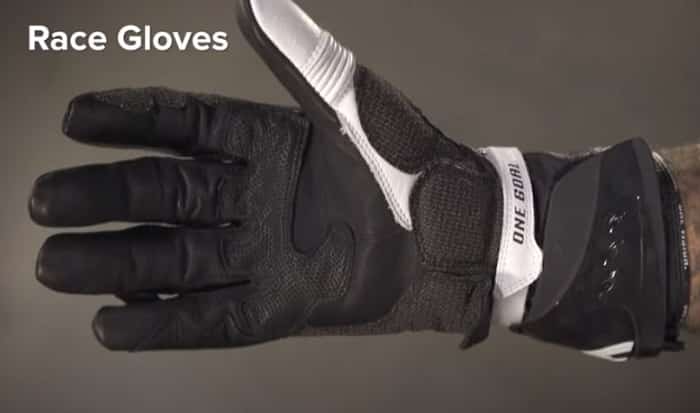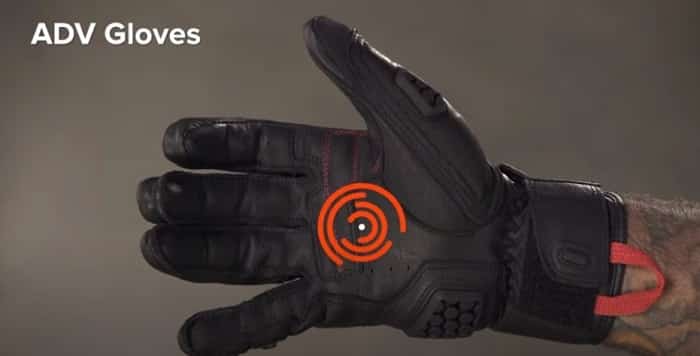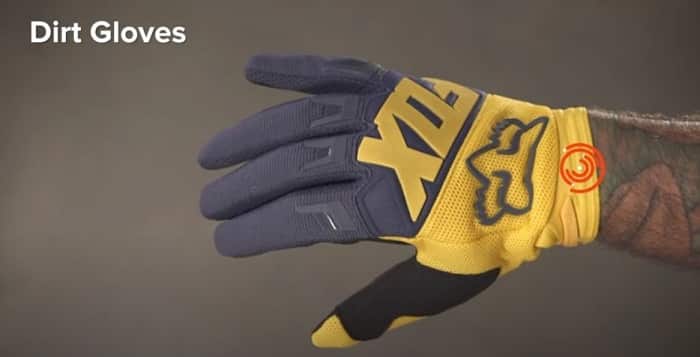Deprecated: mb_convert_encoding(): Handling HTML entities via mbstring is deprecated; use htmlspecialchars, htmlentities, or mb_encode_numericentity/mb_decode_numericentity instead in /home/u598013642/domains/motorcyclegear101.com/public_html/wp-content/themes/acabado/functions.php on line 2160
Deprecated: mb_convert_encoding(): Handling HTML entities via mbstring is deprecated; use htmlspecialchars, htmlentities, or mb_encode_numericentity/mb_decode_numericentity instead in /home/u598013642/domains/motorcyclegear101.com/public_html/wp-content/themes/acabado/functions.php on line 2160
If you are riding a motorcycle in any situations you should wear motorcycle gloves. There are three different materials used, some are weatherproof some aren’t but which kind of glove is best for you?
The type of riding you do will determine what kind of motorcycle gloves you need. Gloves used for a street bike, touring, or a Dirt bike will be totally different. One will require flexibility, the other protections, and another durability.
There are a wide variety of great gloves across all price points. While the price of a pair of gloves can affect the materials it’s made from and subsequently how comfortable it is, it doesn’t necessarily affect how protective a pair of gloves is.
Glove Type Pro & Cons
| Leather Gloves | Pro | Cons |
|---|---|---|
| Abrasion Resistant | Large Investment | |
| Longevity | Waterproof Options Limited | |
| Molds To Hands |
| Textile Gloves | Pro | Cons |
|---|---|---|
| Waterproof Options Available | Doesn’t Mold To Hand | |
| Multi-Seasonal | One-Time Crash Use | |
| Consistent Fit | Liners Cause Bulk |
| Hybrid Gloves | Pro | Cons |
|---|---|---|
| Abrasion Resistant | Limited Durability | |
| Multi-Seasonal | Liners Cause Bulk | |
| Waterproof Options Available |
When we talk about protection, we’re talking about impact protection, abrasion resistance, as well as protection from the elements.
Throughout this review, we’re not going to dive into specifics. If you want specifics on a pair of gloves that you’re considering, make sure you check out the detailed product page to find out exactly how protective those gloves are.
Even if you’re new to motorcycling, chances are you’ve heard us talk about two different types of materials: Textile versus leather.
Historically there’s been a debate over which is safer. We found that with modern-day textiles, they’re going to be just as safe as leather gloves in the event of a street crash.
The main difference s that after the crash, textiles will usually have to be replaced. Leather gloves can survive multiple crashes, or they can be repaired if required.
Glove Materials
Leather is often used in the manufacturing of gloves because of the high levels of protection it provides while at the same time generously giving you a great feel for lever control.
Some of the pros of leather are they have a high level of abrasion resistance, it can frequently survive multiple crashes, and you’re looking at a pair of gloves that will break in and get more comfortable over time.
Leather Gloves Pro & Cons
Pro
- Abrasion Resistant
- Longevity
- Molds To Hands
Cons
- Large Investment
- Waterproof Options Limited
One of the cons of leather is that it’s usually more expensive than its textile counterparts. It’s not going to be ideal for waterproofing. It’s typically not the best in extreme temperatures.
Textiles are used in the manufacturing of gloves because they offer a wide range of possibilities for protecting riders from extreme weather and crash conditions.
Textile Gloves
Some of the pros of textile gloves are they’re ideal for waterproof protection.
You’re also looking at a pair of gloves that will give you options for temperature extremes, both hot and cold, and they’re not going to have a break-in period the way that leather would. You get a consistent fit right out of the box.
Pro
- Waterproof Options Available
- Multi-Seasonal
- Consistent Fit
Cons
- Doesn’t Mold To Hand
- One-Time Crash Use
- Liners Cause Bulk
Some of the cons of textile are that they’re not going to break in and get more comfortable over time,
You’re going to be looking at a glove that’s pretty much going to be a one-time use in the event of a crash, and those thermal and waterproof liners can feel a bit bulky.
The textile can be combined in a hybrid to give you the best of both worlds.
Hybrid Gloves
When you’re looking at a leather textile option for gloves, some of the pros here will be that you get the abrasion resistance and tactile feedback of leather while simultaneously offering some of the weather protection that textiles give you.
You can get mesh at the back of the hands for hot weather riding, or you can get more complex liner systems in there to help combat the cold. You can also add some usable waterproof options.
Pro
- Abrasion Resistant
- Multi-Seasonal
- Waterproof Options Available
Cons
- Limited Durability
- Liners Cause Bulk
However, some of the cons are that it’s not going to be as durable as a true full leather glove in the event of a crash, and those liner systems can still be a bit bulky.
Glove Types
So let’s jump into the different types of gloves available, kicking things off with street gloves.
Street Gloves
Street gloves will probably be the most popular pair of gloves; simply because of the wide variety of motorcycles they’re going to work with.
Steet gloves are short cuff gloves designed for all-day comfort. Materials utilized are all three. Leather, textile, as well as a combination of both depending on the pair of gloves you’re looking at.
Why Do Motorcycle Gloves Have Hard Knuckles?
You’re going to start to see impact armor incorporated into the glove as well as options for waterproof protection.
You’ll have touchscreen fingertips available in certain models, and that’s going to be great for those of you out there using a smartphone on your day to day ride.
Because of the wide variety of different types of street clubs available, you can have a wide variety of price points to consider.
Your second option for gloves is going to be designed for race and track use. These will be almost exclusively full gauntlet in their design and leather in construction because they’re aimed at maximizing protection as well as maneuverability.

Because of the protection, you’re going to see a lot of armor coming into play, and you’ll rarely see a waterproof option. Because of the complexity of these gloves’ design, they’re going to sit at a more expensive price point.
Your third option to consider are gloves designed for touring use. Touring gloves are typically full gauntlet in their design to deal with all-weather riding situations.
From a material standpoint, we’re looking at a mostly textile or textile leather hybrid. The idea is to aim at both comforts, as well as protection.
So you’re going to see protection and key elements, like your palms, your pinky as well your knuckles.

With touring gloves, you’re going to see things like touchscreen capability at the index finger as well as the thumb.
You can use this with a GPS or a smartphone when you’re out there navigating on the road.
Because of the variety of complexities within the design and the materials being used, touring gloves typically sit at a mid to high-level price point.
ADV Gloves
The fourth option for gloves you are going to see is aimed squarely at dual-sport and adventure riders.
These will be short cuff in their design, and they’re aimed at maximum maneuverability and impact protection.
From a material standpoint, typically, what we’re going to see is going to be leather at the palm, as well as a mesh or textile on the back of the hand.
We’re now starting to see things like touch screen fingertips incorporated so that you can use them with your smartphone or GPS.
There are also a few different waterproof options popping up because of the simplicity of this design. ADV gloves are going to sit right around the mid-level price point normally.

Dirt Bike Gloves
The last option we are going to look at is specifically aimed at dirt riders.
Dirt bike gloves are short cuff in their design, and they focus on maximizing maneuverability and comfort over protection.
Because of that, the materials will almost exclusively be textile with a max amount of stretch built-in.
Because the focus here is on maneuverability, there’s not going to be any impact protection, and therefore they’re not ideal for street use.
What you’re going to get is a very simple glove, and because of that, the price point is going to be reflected. It’s going to be a very affordable option.
Keep in mind that these gloves tend to wear out every season or two because of that affordability, so they will have to be replaced.

Glove Fit
Now that you’ve narrowed down the style you’re looking for, and we must identify your preferred fit.
When we talk about fitting fur gloves, we’re going to talk about American Fit and European fit.
While these gloves might look identical sitting on the table, they have two distinctly different fits if you try them on.
When we refer to a thick American glove, we’re talking about gloves designed by an American manufacturer, and they have a more relaxed fit overall.
While we’ve seen some European manufacturers shift to a more relaxed fit, we’re still going to refer to an American fit glove if it’s going to have additional room around the circumference of the palm, circumference of the finger, and slightly less length throughout the entire glove.
When we talk about European fit gloves, typically, these are gloves designed by folks outside of the US, and they’re focused on a more snug and secure aggressive fit.
So what this means for you is that the gloves will be narrower around the circumference of your palm, the circumference of your fingers, but you’ll have additional length at the fingertips.
When you’re trying gloves on, what you want is a glove that fits you nice and snug throughout while still allowing for a comfortable range of motion.
You don’t want gloves that are going to cause fatigue after a long day in the saddle.
One thing to keep in mind is that if you’re considering gloves with a thermal or a waterproof liner, they can feel a bit bulkier than gloves with no liners.
How do I know My Motorcycle Glove Size?
Once you’ve determined the style and the fit you’re looking for, the only thing left is to get your correct size.
There are two different approaches to measuring motorcycle gloves.
One is going to be hand width, and the other one is going to be hand circumference.
It would be best if you looked at the size chart for the gloves you’ve selected to see how they’re getting that measurement.
You will also want to check and see whether they measure in centimeters or inches.
If the measurement you’re looking for is a hand width measurement, start by laying the tape measure flat on the table and rest your hand over the top of it.
With an open hand, measure the widest part of your palm. Repeat this with both hands and use the larger of the two numbers if one hand is bigger than the other.

If the size chart requires a circumference measurement, with an open palm, wrap a cloth measuring tape around your hand behind the knuckles, but don’t include the thumb.
Make sure to keep the tape nice and snug and measure both your left and your right hands. Again, you want to use the larger the two measurements to determine your correct size.
That being said, there can be some inconsistencies with gloves. Some might tend to run large or run small, and if we notice this trend will do our best to put a note on the product page.
Considering now, you should have a pair of gloves that are sized correctly at this point in this guide and match up with your preferred style and fitment.
So when they show up, wear them around the house, and sit on the motorcycle. Try out the controls and make sure that you’re happy with the range of motion.
Keep in mind a pair of textile gloves should fit perfectly right out of the box, while leather gloves will tend to break in overtime.
The one thing you cannot do is go out and ride in the gloves until you’re 100% sure they fit you correctly.
If you’re happy with the gloves and don’t feel any discomfort, congratulations, you have found your next pair of motorcycle gloves.


